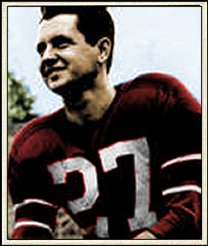107 Packers played during the nine years Vince Lombardi coached in Green Bay. Two of those men, Bob Long and Tom Brown, also played for Vince in 1969 in Washington. 45 of the remaining 105 played for at least one other Hall of Fame coach during their NFL careers. Three of those 45 actually played for more than one other Hall of Fame coach.
In addition to three games for Lombardi, kicker Ben Agajanian also appeared in one game for Greasy Neale, 12 games for Steve Owen, 17 games for Sid Gillman and three for Hank Stram. That’s five Hall of Fame coaches for the itinerant footman!
Receiver Gary Barnes played for Lombardi as a rookie in 1962, for Tom Landry in 1963 and for George Halas in 1964. Three Hall of Fame coaches in three years. In 1965, he took a giant step down and played minor league ball before becoming one of the first two players signed by the expansion Atlanta Falcons for 1966. He eventually became a municipal court judge in Clemson, South Carolina.
Center Bill Curry played two years with Lombardi, three with Don Shula and one-half season with Sid Gillman. He has frequently spoken and written about the differences of his first two charismatic NFL coaches. In essence, his opinion seems to be that Lombardi unpleasantly forced him to grow up and become a man, and while Curry is grateful for that, Shula was more humane.
Here’s the Hall of Fame coach breakdown:
Tom Landry (11): Adderley, Barnes, Borden, Butler, Caffey, Cvercko, Folkins, Gregg, McIlhenny, Norton, Roach.
Paul Brown (7): Bob Brown, Carpenter, Davis, Freeman, Jordan, Quinlan, A.D. Williams.
George Allen (7): Currie, Dowler, Gremminger, Iman, Moore, Pitts, Robinson.
Don Shula (5): Tim Brown, Curry, Fleming, Grimm, Kostelnik.
George Halas (3): Barnes, Bettis, Bratkowski.
Weeb Ewbank (3): McHan, Mercein, Thurston.
Sid Gillman (3): Agajanian, Curry, Whittenton.
Chuck Noll (3): Gros, Rowser, Voss.
Steve Owen (2): Agajanian, Tunnell.
Bud Grant (2): Dale, Hackbart.
John Madden (2): Ben Davidson, Howie Williams.
Greasy Neale (1): Agajanian.
Hank Stram (1): Agajanian.
A few other coaches who may one day be elected to the Hall also employed Lombardi players. Buddy Parker used eight, Buck Shaw two, Chuck Knox two and Don Coryell and Lou Saban one a piece.
(Custom Ben Agajanian 1961 Fleer, custom 1962 Topps Gary Barnes and custom 1966 Philadelphia Bill Curry)



























